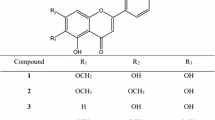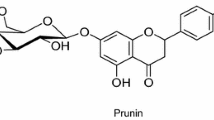Abstract
Caffeoylquinic acids, flavonoids, and coumarins isolated from Artemisia capillaris have recently emerged as therapeutic candidates for diabetes and diabetic complications; however, there have been very few studies of the anti-diabetic potential of polyacetylenes. In the present study, we investigated the anti-diabetic potential of two polyacetylenes isolated from A. capillaris, namely capillin and capillinol by investigating their ability to inhibit α-glucosidase, protein tyrosine phosphatase 1B (PTP1B), and rat lens aldose reductase (RLAR). Capillin displayed potent inhibitory activity against α-glucosidase, PTP1B, and RLAR, while capillinol showed moderate inhibitory activity against α-glucosidase and PTP1B at the concentrations tested. In addition, a kinetic study revealed that capillin inhibited α-glucosidase and RLAR in a noncompetitive manner, while inhibited PTP1B in a mixed-type manner. Capillinol inhibited α-glucosidase and PTP1B in a mixed-type manner. Docking simulations of these compounds demonstrated negative binding energies and close proximity to residues in the binding pocket of PTP1B, indicating that these polyacetylenes have a high affinity and tight binding capacity for the active site of the enzyme. Furthermore, capillin dose-dependently inhibited peroxynitrite (ONOO−)-mediated tyrosine nitration. The results clearly demonstrate the promising potential of capillin and capillinol as therapeutic interventions for the management of diabetes as well as diabetes-associated complications.






Similar content being viewed by others
References
Ahmad F, Considine RV, Bauer TL, Ohannesian JP, Marco CC, Goldstein BJ (1997) Improved sensitivity to insulin in obese subjects following weight loss is accompanied by reduced protein tyrosine phosphatase in adipose tissue. Metabolism 46:1140–1145
Aulak KS, Miyagi M, Yan L, West KA, Massillon D, Crabb JW, Stuehr DJ (2001) Proteomic method identifies proteins nitrated during inflammatory challenge. Proc Natl Acad Sci USA 98:12056–12061
Brownlee M (2001) Biochemistry and molecular cell biology of diabetic complications. Nature 414:813–820
Burke TR Jr, Zhang ZY (1998) Protein–tyrosine phosphatases: structure, mechanism, and inhibitor discovery. Biopolymers 47:225–241
Bustanji Y, Al-Masri IM, Qasem A, Al-Bakri AG, Taha MO (2009) In silico screening for non-nucleoside HIV-1 reverse transcriptase inhibitors using physicochemical filters and high-throughput docking followed by in vitro evaluation. Chem Biol Drug Des 74:258–265
Chang SL, Chang CL, Chiang YM, Hsieh RH, Tzeng CR, Wu TK, Sytwu HK, Shyur LF, Yang WC (2004) Polyacetylenic compounds and butanol fraction from Bidens pilosa can modulate the differentiation of helper T cells and prevent autoimmune diabetes in non-obese diabetic mice. Planta Med 70:1045–1051
Cheng AY, Fantus IG (2005) Oral antihyperglycemic therapy for type 2 diabetes mellitus. CMAJ 172:213–226
Cheng A, Dubé N, Gu F, Tremblay ML (2002) Coordinated action of protein tyrosine phosphatases in insulin signal transduction. Eur J Biochem 269:1050–1059
Christensen PL, Brandt K (2006) Bioactive polyacetylenes in food plants of the Apiaceae family: occurrence, bioactivity and analysis. J Pharm Biomed Anal 41:683–693
Cui L, Na MK, Oh H, Bae EY, Jeong DG, Ryu SE, Kim S, Kim BY, Oha WK, Ahn JS (2006) Protein tyrosine phosphatase 1B inhibitors from Morus root bark. Bioorg Med Chem Lett 16:1426–1429
Cui CB, Jeong SK, Lee YS, Lee SO, Kang IJ, Lim SS (2009) Inhibitory activity of caffeoylquinic acids from the aerial parts of Artemisia princeps on rat lens aldose reductase and on the formation of advanced glycation end products. J Korean Soc Appl Biol Chem 52:655–662
Fusetani N, Li H, Tamura K, Matsunaga S (1993) Antifungal brominated C18 acetylenic acids from the marine sponge Petrosia volcano Hoshino. Tetrahedron 49:1203–1210
Goodarzi MT, Zal F, Malakooti M, Safari MR, Sadeghian S (2006) Inhibition of lens aldose reductase by flavonoids. Acta Med Iran 44:41–45
Hallock FY, Cardellina HJ, Balaschak SM, Alexander RM, Prather RT, Shoemaker HR, Boyd MR (1995) Antitumor activity and stereochemistry of acetylenic alcohols from the sponge Cribrochalina vasculum. J Nat Prod 58:1801–1807
Hayman S, Kinoshita JH (1965) Isolation and properties of lens aldose reductase. J Biol Chem 240:877–882
Hudson BI, Hofmann MA, Bucciarelli L, Wendt T, Moser B, Lu Y, Qu W, Stern DM, D’Agati V, Yan SD, Yan SF, Grant PJ, Schmidt AM (2002) Glycation and diabetes: the RAGE connection. Curr Sci 83:1515–1520
Hung HY, Qian K, Morris-Natschke SL, Hsu CS, Lee KH (2012) Recent discovery of plant-derived anti-diabetic natural products. Nat Prod Rep 29:580–606
International Diabetes Federation (2013) IDF diabetes Atlas, 6th ed. International Diabetes Federation, Brussels. http://www.idf.org/diabetesatlas
Islam MN, Jung HA, Sohn HS, Kim HM, Choi JS (2013) Potent α-glucosidase and protein tyrosine phosphatase 1B inhibitors from Artemisia capillaris. Arch Pharm Res 36:542–552
Islam MN, Ishita IJ, Jung HA, Choi JS (2014) Vicenin 2 isolated from Artemisia capillaris exhibited potent anti-glycation properties. Food Chem Toxicol 69:55–62
Jung HA, Park JJ, Islam MN, Jin SE, Min BS, Lee JH, Sohn HS, Choi JS (2012) Inhibitory activity of coumarins from Artemisia capillaris against advanced glycation endproduct formation. Arch Pharm Res 35:1021–1035
Lee JR, Kim JK, Lee SJ, Kim KP (2009) Role of protein tyrosine nitration in neurodegenerative disease and atherosclerosis. Arch Pharm Res 32:1109–1118
Lee DH, Cho HJ, Kang HY, Rhee MH, Park HJ (2012) Total saponin from Korean Red ginseng inhibits thromboxane A2 production associated microsomal enzyme activity in platelets. J Ginseng Res 36:40–46
Li T, Zhang XD, Song YW, Liu JW (2005) A microplate-based screening method for α-glucosidase inhibitors. Chin J Clin Pharmacol Ther 10:1128–1134
Lillelund VH, Jensen HH, Liang X, Bols M (2002) Recent developments of transition-state analogue glycosidase inhibitors of non-natural product origin. Chem Rev 102:515–553
Logendra S, Ribnicky DM, Yang H, Poulev A, Ma J, Kennelly EJ, Raskin I (2006) Bioassay-guided isolation of aldose reductase inhibitors from Artemisia dracunculus. Phytochemistry 67:1539–1546
Luo L, Wang R, Wang X, Ma Z, Ning Li N (2012) Compounds from Angelica keiskei with NQO1 induction, DPPH• scavenging and α-glucosidase inhibitory activities. Food Chem 131:992–998
Morris GM, Huey R, Lindstrom W, Sanner MF, Belew RK, Goodsell DS, Olson AJJ (2009) AutoDock4 and AutoDockTools4: automated docking with selective receptor flexibility. J Comput Chem 30:2785–2791
Okada Y, Miyauchi N, Suzuki K, Kobayashi T, Tsutsui C, Mayuzumi K, Nishibe S, Okuyama T (1995) Search for naturally occurring substances to prevent the complications of diabetes. II. Inhibitory effect of coumarin and flavonoid derivatives on bovine lens aldose reductase and rabbit platelet aggregation. Chem Pharm Bull 43:1385–1387
Shah MR, Ishtiaq Hizbullah SM, Habtemariam S, Zarrelli A, Muhammad A, Collina S, Khan I (2015) Protein tyrosine phosphatase 1B inhibitors isolated from Artemisia roxburghiana. J Enzyme Inhib Med Chem 29:1–5
Shim H, Moon JS, Lee S, Yim D, Kang TJ (2012) Polyacetylene Compound from Cirsium japonicum var. ussuriense inhibited caspase-1-mediated IL-1β expression. Immune Netw 12:213–216
Stadtman ER, Berlett BS (1998) Reactive oxygen-mediated protein oxidation in aging and disease. Drug Metab Rev 30:225–243
Sugimoto N, Tada A, Yamazaki T, Tanamoto K (2007) Antimicrobial activity and constituents in Rumput roman extract as a natural food preservative. Shokuhin Eiseigaku Zasshi 48:106–111
Tang W, Eisenbrand G (1992) Chinese drugs of plant origin, chemistry, pharmacology and use in traditional and modern medicine. Springer, New York, p 179
Tomlinson DR, Stevens EJ, Diemel LT (1994) Aldose reductase inhibitors and their potential for the treatment of diabetic complications. Trends Pharmacol Sci 15:293–297
Toshihiro I, Masashi M, Masayasu T (2009) Insecticidal activity of capillin isolated from the herbal medicine Inchinko against the cigarette beetle, Lasioderma serricorne (F.) (Coleoptera: Anobiidae). Appl Entomol Zool 44:497–500
Toshitsugu F, Hiroshi A, Noritaka H, Toshiaki K (1975) Synthesis and bioactivity of novel acetylenic compounds. Agr Biol Chem 39:519–527
Ubillas RP, Mendez CD, Jolad SD, Luo J, King SR, Carlson TJ, Fort DM (2000) Antihyperglycemic acetylenic glucosides from Bidens pilosa. Planta Med 66:82–83
Whelan LC, Ryan MF (2004) Effects of the polyacetylene capillin on human tumour cell lines. Anticancer Res 24:2281–2286
Acknowledgments
This research was supported by the Basic Science Research Program through the National Research Foundation of Korea (NRF) and by the Ministry of Education (2012R1A6A1028677) and was also partially assisted by the Korean Bioinformation Center (KOBIC) Research Support Program.
Conflict of Interest
The authors declare no conflict of interest.
Author information
Authors and Affiliations
Corresponding authors
Additional information
Md. Nurul Islam and Ran Joo Choi have contributed equally to this work.
Rights and permissions
About this article
Cite this article
Islam, M.N., Choi, R.J., Jung, H.A. et al. Promising anti-diabetic potential of capillin and capillinol isolated from Artemisia capillaris . Arch. Pharm. Res. 39, 340–349 (2016). https://doi.org/10.1007/s12272-016-0715-y
Received:
Accepted:
Published:
Issue Date:
DOI: https://doi.org/10.1007/s12272-016-0715-y




